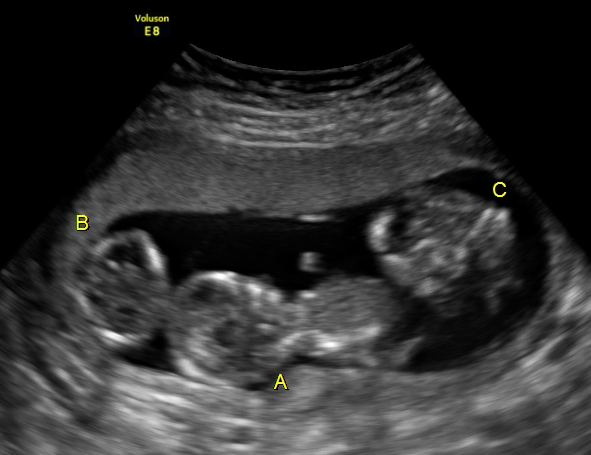toh
Triplets and More
 Triplet pregnancies are generally rare, occurring spontaneously about 1/7000 pregnancies. Approximately 60 % of triplet pregnancies are associated with the use of reproductive technologies. Many mothers undergoing in vitro fertilization with implantation of one or two embryos are often shocked to learn at their first ultrasound that three babies are present in the uterus. This splitting of a fertilized egg into two or more individuals can occur after the embryo is transferred to the uterus. Triplet pregnancy present five times the risk of a singleton pregnancy. For example, the fetal death rate in singleton pregnancies is approximately 6 per 1,000 births, whereas in multiples the rate is 17.4 per 1,000. In addition to the medical risks involved, there are additional considerations for a family expecting three babies at once: sleep deprivation, financial implications, impact on other siblings and on the marriage.
Triplet pregnancies are generally rare, occurring spontaneously about 1/7000 pregnancies. Approximately 60 % of triplet pregnancies are associated with the use of reproductive technologies. Many mothers undergoing in vitro fertilization with implantation of one or two embryos are often shocked to learn at their first ultrasound that three babies are present in the uterus. This splitting of a fertilized egg into two or more individuals can occur after the embryo is transferred to the uterus. Triplet pregnancy present five times the risk of a singleton pregnancy. For example, the fetal death rate in singleton pregnancies is approximately 6 per 1,000 births, whereas in multiples the rate is 17.4 per 1,000. In addition to the medical risks involved, there are additional considerations for a family expecting three babies at once: sleep deprivation, financial implications, impact on other siblings and on the marriage.
 Similar to twin pregnancy, preterm birth remains the greatest hazard to newborns of higher order multiple pregnancies. In our local experience, approximately 30 % of triplet pregnancies result in birth before 34 weeks of gestation either spontaneously or indicated because of maternal or fetal problems. The average gestational age at birth for all babies in Canada is 39 weeks, whereas it drops to 35 weeks for twin births and 31 weeks for triplets or higher order pregnancies (Vanier Institute of the Family, 2017). This means that 55 % of all babies born as a result of multiple pregnancy will be born of low birth weight (less than 2,500 grams or 5.5.pounds) and many are born at very low birth weight (less than 1,500 grams). This can require several weeks of specialized care for the triplets in a NICU.
Similar to twin pregnancy, preterm birth remains the greatest hazard to newborns of higher order multiple pregnancies. In our local experience, approximately 30 % of triplet pregnancies result in birth before 34 weeks of gestation either spontaneously or indicated because of maternal or fetal problems. The average gestational age at birth for all babies in Canada is 39 weeks, whereas it drops to 35 weeks for twin births and 31 weeks for triplets or higher order pregnancies (Vanier Institute of the Family, 2017). This means that 55 % of all babies born as a result of multiple pregnancy will be born of low birth weight (less than 2,500 grams or 5.5.pounds) and many are born at very low birth weight (less than 1,500 grams). This can require several weeks of specialized care for the triplets in a NICU.
For all babies, gestational age at birth is powerful influencer of eventual outcome both in terms of survival and normal physical and mental development. Hence your doctor will discuss signs and symptoms of preterm birth at your antenatal visits, and interventions to maximize the outcome for babies of triplet pregnancy born prematurely. Preterm birth is highly influenced by the number of babies in the uterus. Given that the preterm birth rate is lowest when the number of babies in the uterus is lowest, many parents consider the difficult choice of whether to maintain a triplet pregnancy or reduce the number of fetuses to one or two, through a medical procedure known as multifetal pregnancy reduction. This choice is difficult for both parents and doctors, and extensive counselling around this issue and the risks and benefits is required in order to make an informed choice. Fortunately, there are decision aids available to help patients make this difficult decision. In our specialized experience, approximately 15 % of parents make the difficult decision to reduce the pregnancy to twins or a singleton. In 10 % of triplet pregnancies there will be a spontaneous reduction in the number of live babies to two or one through demise of one or more fetuses.
As with twins, the outcome of triplet pregnancies is highly influenced by the type of placenta, or chronicity. This is determined by the timing of the split in the early embryo after fertilization, long before pregnancy is confirmed. The presence of just one placenta, a “monochorionic” placenta, being shared by all three babies in a triplet pregnancy presents the highest-risk situation. These pregnancies can be affected by all the same conditions that can complicate twin pregnancies (see special twin conditions).
Last updated on: April 30th, 2021


 To reset, hold the Ctrl key, then press 0.
To reset, hold the Ctrl key, then press 0.